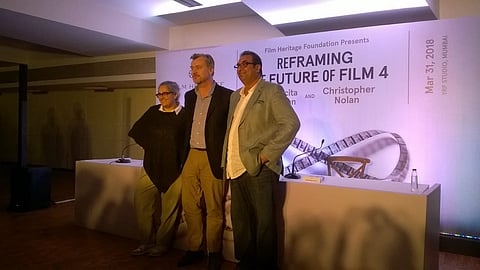
- Reviews
- Power List 2024
- Cannes 2024
- In-Depth Stories
- Web Stories
- News
- FC Lists
- Interviews
- Features
- FC SpecialsFC Specials

When Film Heritage Foundation director Shivendra Singh Dungarpur announced that tickets to a 70mm IMAX screening of Dunkirk in Wadala sold out within 10 minutes of going live, its director Christopher Nolan retorted, "Because it's a good film."
His cheeky comment was a brief moment of levity in an otherwise solemn panel discussion titled 'Reframing the Future of Film', the fourth edition of a series that began at Los Angeles' Getty Museum in 2015. At Yash Raj Film Studios in Andheri, Dungarpur, Nolan and visual artist Tacita Dean, founding member of savefilm.org, spoke about the need to preserve photo-chemical film and the obstacles they faced while doing so.
We've spent the last few years explaining that film is here to stay. It's a wonderful medium that we can all enjoy
"What Tacita and I have been trying to do with these meetings is bring together all the different facets of film production and exhibition to really make the case for the place that celluloid film will have in the future, in a post-digital world and to look at the importance of celluloid film as a medium, not as a technology that is being replaced by digital imagining, but as a creative medium that Tacita, as an artist, and I as a narrative filmmaker depend upon," said Nolan, currently on a three-day visit to Mumbai.
He said it had an important part to play in preserving the history of film for future generations, who would then be able to watch movies "in the way the filmmakers intended".
No film is logical or pragmatic. Films are about dreams and about magic and about escapism
The Censor Board's records show that in 2010, there were 1,274 feature-length films shot on celluloid and none on digital. By contrast, just one feature-length film was shot on celluloid and 1,986 on digital format between 2016 and 2017. Dungarpur, who has shot on celluloid himself, called the fight to save film a "battle", saying people had not realised its importance.
"We shouldn't forget that in India, till 2014, we were still shooting on film. When I shot (2012 film) Celluloid Man, I actually shot on every possible camera, whether it was a Super 8, 16, even a 70 Panavison. This was because I wanted to experiment. In the history of film, what is fascinating to me is the transition of different periods and formats and the change we're seeing. I wanted to have all that in one film because I didn't know when I would get a chance to shoot different formats again. I think that preserving different formats, different forms of celluloid, that's challenging now for us," he said.
He said that when he was told it was too expensive to ship his prints of Celluloid Man to Telluride, he offered to pay for it himself, as he wanted audiences to see it the way he had intended.
We have been reading reports everyday of how many films have been lost or thrown in godowns
Nolan said accusations that celluloid was too expensive or difficult or that there weren't any projectionists left were myths designed to undermine the medium. "There's been a very powerful financial incentive for electronic companies and technology companies to try and transform the industry. But, we've spent the last few years explaining that film is here to stay. It's a wonderful medium that we can all enjoy," said Nolan.
"When discussions have arisen in the past about why somebody would choose to shoot in film, even if it seems more difficult than shooting in digital, they speak as if filmmaking was a logical and pragmatic thing to do and it's not. No film is logical or pragmatic. Films are about dreams and about magic and about escapism," he added.
On the problems plaguing Indian films, Dungarpur said people had begun digitally transferring them, disrespecting their formats and aspect ratios. "We have been reading reports everyday of how many films have been lost or thrown in godowns. We're just seeing the sad way celluloid has been neglected." Tacita agreed, saying that not just cinema in India but that of the world had, in a mass way, become digital cinema.
I'm just trying to position and empower filmmakers to view their choice of medium as one of the things they have to fight for.
"The beginning of our discussions were about how to encourage people to shoot on film again, saying that it's available, and to counteract the negativity and the pessimism around them. We're not trying to go back, we're trying to go into the future," said Tacita.
Both were happy to report that their efforts had yielded results, with cinematographers Sudeep Chatterjee and Santosh Sivan pledging to shoot their next films on celluloid.
"What's been really exciting about meeting with leading members of the Indian film community is the spirit of optimism about the future," said Nolan, who ended the discussion with advice for aspiring filmmakers. "I think making films is always about facing seemingly insurmountable odds. Anybody can try to go on and direct a film. To get a budget, to get a crew together, you have to surmount all kinds of obstacles. I'm just trying to position and empower filmmakers to view their choice of medium as one of the things they have to fight for. None of these fights are easy, especially when you're just starting out. But it's one of the things you have to fight for."